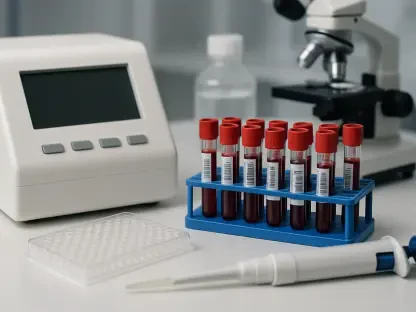The radiopharmaceutical imaging market stands at the forefront of a transformative era in healthcare, with projections indicating a remarkable surge from $7.02 billion in 2024 to an impressive $12.0 billion by 2035. This growth is driven by a consistent compound annual growth rate (CAGR) of 5.0% over the forecast period spanning 2025 to 2035, as highlighted in a recent industry press release. This specialized sector, deeply rooted in nuclear medicine, focuses on diagnostic radiopharmaceutical agents that enable clinicians to visualize molecular processes within the body, offering critical insights into complex health conditions. Techniques such as Positron Emission Tomography (PET) and Single Photon Emission Computed Tomography (SPECT) rely on isotopes like technetium-99m and fluorine-18 to detect diseases ranging from cancer to cardiovascular issues. As the demand for early and accurate diagnostics continues to rise, this market is becoming an indispensable pillar of modern medical practice, shaping the future of personalized healthcare solutions with its innovative approaches.
Forces Behind Market Expansion
The momentum propelling the radiopharmaceutical imaging market forward is largely attributed to rapid technological advancements and the growing burden of chronic diseases worldwide. Innovations in hybrid imaging systems, such as PET/CT and PET/MRI, have significantly improved diagnostic precision, allowing healthcare professionals to identify abnormalities at much earlier stages. These systems, paired with cutting-edge radiotracers, offer a detailed view of physiological functions, which is particularly vital for managing conditions like cancer and heart disease. Beyond the technology itself, substantial investments in research and development are fostering the creation of next-generation imaging agents, further enhancing the capabilities of nuclear medicine. This continuous push for innovation not only addresses current diagnostic needs but also anticipates future challenges in patient care, ensuring that the industry remains agile and responsive to evolving healthcare demands.
Another critical factor driving this market is the escalating prevalence of chronic illnesses, coupled with demographic shifts that necessitate advanced diagnostic tools. The rise in cancer, cardiovascular disorders, and neurological conditions has created an urgent need for reliable imaging solutions, with oncology emerging as a dominant application area due to the pivotal role of radiopharmaceuticals in tumor detection and monitoring. An aging global population, more susceptible to such health issues, further amplifies the demand for frequent diagnostic procedures. This trend is complemented by increasing patient awareness and higher healthcare expenditures, which collectively sustain the market’s growth trajectory. As societies grapple with these health challenges, radiopharmaceutical imaging offers a pathway to earlier interventions and better outcomes, aligning with the broader shift toward proactive and preventive medical strategies.
Diverse Applications and Market Structure
Delving into the structure of the radiopharmaceutical imaging market reveals a broad spectrum of applications and technologies tailored to meet varied clinical needs. Key areas of use include oncology, cardiology, and neurology, with cancer diagnostics leading due to the high incidence of the disease and the essential function of radiopharmaceuticals in staging and tracking treatment progress. Hospitals and diagnostic imaging centers serve as the primary end-users, equipped with the infrastructure to deploy these advanced tools effectively for patient care. This segmentation underscores the versatility of radiopharmaceutical agents in addressing a wide array of medical conditions, ensuring that healthcare providers have access to specialized solutions that enhance diagnostic accuracy. The market’s ability to cater to diverse medical fields highlights its integral role in supporting comprehensive health management systems across different settings.
Further examination of the market’s composition shows a range of imaging modalities that define its technological landscape. PET and SPECT remain foundational, providing critical insights into functional processes, while hybrid systems like PET-CT are gaining traction for their ability to merge anatomical and functional data into a single, cohesive image. This integration allows for a more thorough understanding of a patient’s condition, improving decision-making in clinical environments. Additionally, the market encompasses various types of radiopharmaceuticals, including diagnostic agents and targeted tracers, each designed for specific diagnostic purposes. This diversity not only reflects the market’s adaptability but also its capacity to evolve with emerging medical needs, ensuring that it remains relevant in an ever-changing healthcare landscape focused on precision and efficiency.
Global Reach and Regional Variations
Geographically, the radiopharmaceutical imaging market exhibits distinct patterns of growth and opportunity across different regions, each contributing uniquely to the global outlook. North America holds the largest share, driven by its robust healthcare infrastructure, significant funding for research and development, and the presence of leading industry players. The United States and Canada benefit from policies that encourage the adoption of advanced diagnostic technologies, facilitating widespread use of PET and SPECT systems. This regional dominance is further supported by a strong emphasis on innovation and collaboration between academic institutions and industry, ensuring a steady flow of new solutions into the market. As a result, North America serves as a benchmark for technological advancement and market maturity, setting standards that influence global trends in nuclear medicine.
In contrast, Europe emerges as a strong secondary market, with countries like Germany, France, and the UK spearheading progress in nuclear medicine research and clinical application. The region’s growth is bolstered by stringent regulatory frameworks that ensure high standards of safety and efficacy, alongside a commitment to integrating state-of-the-art technologies into healthcare systems. Meanwhile, Asia-Pacific stands out as the fastest-growing region, fueled by rapid development of healthcare infrastructure and increasing awareness of advanced diagnostics in populous nations like China and India. Emerging markets in South America and the Middle East & Africa also present untapped potential, with rising investments and partnerships paving the way for future expansion. These regional dynamics collectively paint a picture of a globally interconnected market, where both developed and developing economies play vital roles in sustaining growth through 2035.
Navigating Challenges and Seizing Opportunities
Despite the promising outlook, the radiopharmaceutical imaging market faces significant challenges that could temper its growth if not addressed strategically. High costs associated with imaging systems and the production of radiopharmaceuticals often limit accessibility, particularly in resource-constrained regions where healthcare budgets are tight. Additionally, stringent regulatory requirements for handling radioactive materials create barriers to market entry and expansion, requiring substantial compliance efforts from industry players. These hurdles are compounded by supply chain issues related to isotope availability, which can disrupt the consistent delivery of diagnostic agents. Addressing these obstacles demands innovative approaches to cost reduction, regulatory harmonization, and supply chain optimization, ensuring that the benefits of advanced imaging reach a broader patient base without compromising safety or quality.
On the flip side, the market is ripe with opportunities that could propel it to new heights over the coming decade. Declining costs of imaging technologies, alongside increased investments in isotope production facilities, are making these tools more accessible to healthcare providers worldwide. The integration of artificial intelligence and machine learning into diagnostic imaging also holds transformative potential, enhancing the speed and accuracy of image interpretation. Furthermore, the growing focus on precision medicine opens avenues for developing highly specific radiopharmaceutical agents tailored to individual patient profiles, driving personalized diagnostics. These opportunities, if leveraged effectively, can mitigate existing challenges and position the market for sustained innovation, ensuring that it continues to meet the evolving needs of global healthcare systems with cutting-edge solutions.
Reflecting on Progress and Future Pathways
Looking back, the radiopharmaceutical imaging market has demonstrated remarkable resilience and adaptability, achieving significant milestones in diagnostic innovation through persistent technological advancements and a steadfast response to rising chronic disease rates. The journey from a niche sector to a projected $12.0 billion industry by 2035 reflects a steady CAGR of 5.0%, underpinned by the critical contributions of regions like North America and the rapid strides made in Asia-Pacific. The dominance of oncology applications and the competitive drive among key players to push boundaries in radiotracer development have marked a period of dynamic growth, despite challenges like high costs and regulatory complexities.
Moving forward, stakeholders must focus on actionable strategies to sustain this momentum, such as fostering public-private partnerships to bolster isotope supply chains and investing in AI-driven diagnostic tools to enhance clinical efficiency. Expanding access in emerging markets through cost-effective solutions and capacity building will be crucial, as will continued advocacy for supportive policies that streamline regulatory processes. These steps, taken collectively, promise to solidify the market’s role as a cornerstone of modern diagnostics, paving the way for improved patient outcomes on a global scale.









